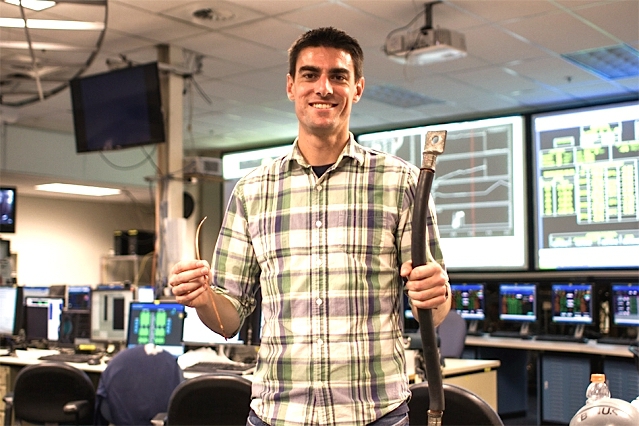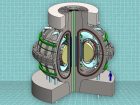
Features
Energy & Power
Generation
Will MIT’s ARC reactor bring about practical nuclear fusion?
August 10, 2015 | By Anthony Capkun

August 10, 2015 – Are practical nuclear fusion plants finally on the horizon? Maybe, because advances in magnet technology have enabled researchers at MIT to propose a new design for a practical compact tokamak fusion reactor—one, they say, that might be realized in as little as a decade.
Using new commercially available superconductors (rare-earth barium copper oxide [REBCO] superconducting tapes) to produce high-magnetic field coils “just ripples through the whole design”, said Dennis Whyte, a professor of Nuclear Science and Engineering and director of MIT’s Plasma Science and Fusion Center. “It changes the whole thing.”
The stronger magnetic field makes it possible to produce the required magnetic confinement of the superhot plasma (the working material of a fusion reaction) but in a much smaller device than those previously envisioned. The reduction in size, in turn, makes the whole system less expensive and faster to build, and also allows for some ingenious new features in the power plant design.
Photo 2 (at bottom): A cutaway view of the proposed ARC reactor. Thanks to powerful new magnet technology, the much smaller, less-expensive ARC reactor would deliver the same power output as a much larger reactor. Illustration courtesy of the MIT ARC team.
A design class taught by Whyte led to a paper on the subject (co-authored by Whyte, Ph.D. candidate Brandon Sorbom and 11 others at MIT), which then became a student-led project after the class ended.
Photo 1: MIT Ph.D. candidate Brandon Sorbom holds REBCO superconducting tapes (left), which are the enabling technology behind the ARC reactor. When it is cooled to liquid nitrogen temperature, the superconducting tape can carry as much current as the large copper conductor on the right, enabling the construction of extremely high‑field magnets, which consume minimal amounts of power. Photo Jose‑Luis Olivares/MIT.
The new reactor is designed for basic research on fusion but also as a potential prototype power plant that could produce significant power. The basic reactor concept and its associated elements are based on well-tested and proven principles developed over decades of research at MIT and around the world, the team says.
“The much-higher magnetic field allows you to achieve much higher performance,” Sorbom said.
Fusion (the nuclear reaction that powers the sun) involves fusing pairs of hydrogen atoms together to form helium, accompanied by enormous releases of energy. The hard part has been confining the superhot plasma—a form of electrically charged gas—while heating it to temperatures hotter than the cores of stars. This is where the magnetic fields are so important; they effectively trap the heat and particles in the hot centre of the device.
While most characteristics of a system tend to vary in proportion to changes in dimensions, the effect of changes in the magnetic field on fusion reactions is much more extreme: the achievable fusion power increases according to the fourth power of the increase in the magnetic field. Thus, doubling the field would produce a 16-fold increase in the fusion power. “Any increase in the magnetic field gives you a huge win,” Sorbom noted.
While the new superconductors do not produce quite a doubling of the field strength, they are strong enough to increase fusion power by about a factor of 10 compared to standard superconducting technology, Sorbom said. This improvement leads to a cascade of potential improvements in reactor design.
The world’s most-powerful planned fusion reactor—a device called ITER under construction in France—is expected to cost around $40 billion. Sorbom and the MIT team estimate that their new design, about half the diameter of ITER (which was designed before the new superconductors became available), would produce about the same power at a fraction of the cost and in a shorter construction time.
But despite the difference in size and magnetic field strength, the proposed reactor—called ARC—is based on “exactly the same physics” as ITER, Whyte said.
Another key advance in the new design is a method for removing the fusion power core from the doughnut-shaped tokamak reactor without having to dismantle the entire device. That makes it especially well-suited for research aimed at further improving the system by using different materials or designs to fine-tune the performance.
As with ITER, the new superconducting magnets would enable the reactor to operate in a sustained way, producing a steady power output, unlike today’s experimental reactors that can only operate for a few seconds at a time without overheating of copper coils.
Another key advantage is that most of the solid blanket materials used to surround the fusion chamber in such reactors are replaced by a liquid material that can easily be circulated and replaced, eliminating the need for costly replacement procedures as the materials degrade over time.
“It’s an extremely harsh environment for [solid] materials,” Whyte said, so replacing those materials with a liquid could be a major advantage.
Right now, as designed, the reactor should be capable of producing about three times as much electricity as is needed to keep it running, but the design could probably be improved to increase that proportion to about five or six times, Sorbom said. So far, no fusion reactor has produced as much energy as it consumes, so this kind of net energy production would be a major breakthrough in fusion technology, the team says.
The design could produce a reactor that would provide electricity to about 100,000 people, they say, adding that devices of a similar complexity and size have been built within about five years.
— With files from David L. Chandler, MIT News Office
Print this page


